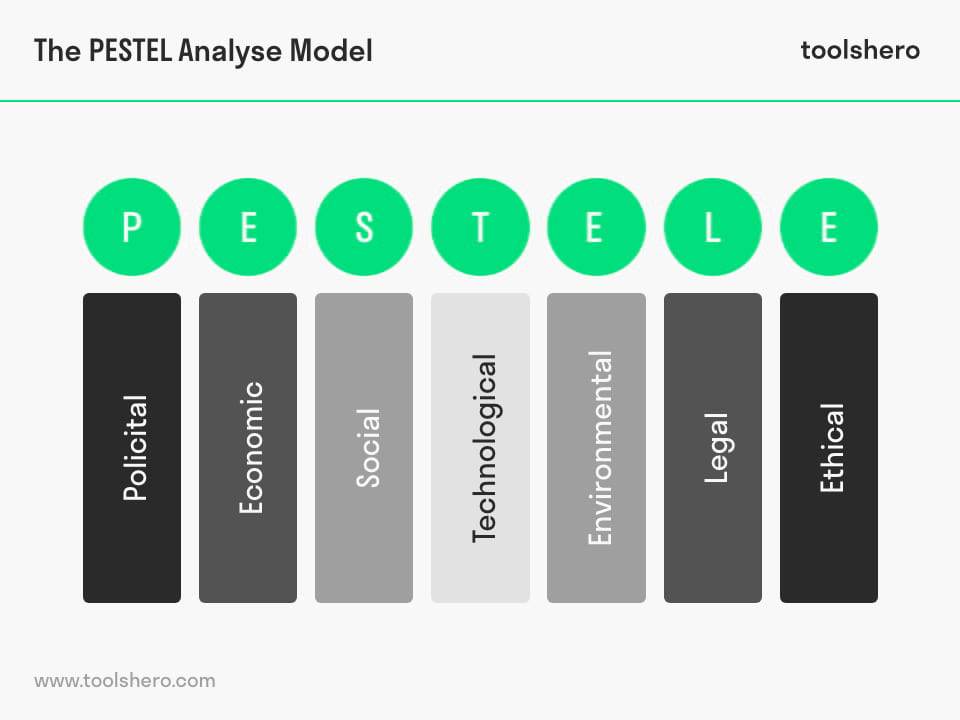PESTEL Analysis explained

PESTEL Analysis: this article explains the PESTEL Analysis in a practical way. Next to what it is including the acronym, this article also highlights the purpose and it’s importance of this marketing strategy tool, the Dependency ofthe PESTEL Factors, explanation of the six factors including examples and a practical PESTEL Analysis template to get started. Enjoy reading!
What is a PESTEL analysis?
Acronym of PESTEL Analysis
PESTEL is an acronym that stands for: Political, Economic, Social, Technological, Environmental and Legal.
The framework is used by marketers to monitor and analyze the macro-environmental factors that affect the organization or industry.
Definition
A PESTEL analysis provides the data that is used in a strategic management analysis, for example for a SWOT Analysis.
What is the purpose of a PESTEL analysis?
The tool is particularly useful when starting a new organization or entering a new, foreign market.
It is often used in conjunction with other tools, such as Porter’s Five Forces Model and the aforementioned SWOT Analysis.
Over the years the framework has expanded, where it started as PEST, now several other factors have been added such as environmental, demographic, intercultural and ethical factors. The result is a collection of variants, including the STEEPLED, DESTEP and SLEPIT models. This article only discusses the PESTEL model. This variant includes most of the relevant factors.
Why is the PESTEL analysis important?
The PESTLE method is a popular method, for example in HR, training and development, organizational development and marketing courses. It underlines the usefulness of taking into account the impact of external factors and forces on the future.
Background PESTEL analysis
Due to the countless variations on the model, it is difficult to trace the exact origin of the model.
However, it is believed that the developer of the first version of the PESTEL model, the PEST Analysis, is Francis J. Aguilar. Aguilar was a management professor at Harvard University, where he developed this macro-analysis tool.
Dependency of the PESTEL analysis Factors
As mentioned before, the PESTEL framework includes 6 different factors. These factors are not all independent of each other. For example, technological progress can interact with the economy and social life within a market.
While performing a PESTEL analysis, the user should always ask themselves important questions. Examples of this are:
- How important is culture in this market? How does culture influence the way of doing business?
- What are the most urgent and important economic factors in this market?
- Are there laws and regulations that regulate and influence the industry? What is the risk of legislative changes affecting the industry?
- What about the environment in this market? Legislation and regulations that must be complied with?
- What about the political situation in this country?
What are the 6 PESTEL factors?
The six PESTEL factors are: Political, Economic, Social, Technological, Environmental and Legal. The six factors are explained below.

Figure 1 – The 6 Basic Elements of the PESTEL Analysis, + Ethical addition
Political factors
Political factors have to do with how the government intervenes in the economy or in a specific sector. This includes government policy, economic policy, political instability, commercial law, corruption, tax law, labor law, environmental law and trade restrictions. The government also has a major influence on a country’s education system, infrastructure and health facilities. These are important factors to consider when assessing a market or industry.
These political factors often help determine the location of the headquarters of large organizations. In particular, tax policy is leading. Politics plays a vital role in business. The balance between control systems and the free market is constantly changing and businesses benefit greatly from closely monitoring developments in this area.
Examples of political factors PESTEL
Other examples of political factors to consider when conducting a PESTEL analysis include:
- Corruption Level
- Tax Policy
- Defense spending
- Trade Control
- Lobby Activities
- Government subsidies
- Special rates
- Press freedom
Economic factors
Economic factors often include indicators of the performance and health of a particular economy. Economic factors are for example economic growth, exchange rates, inflation, interest, etc. These factors have a direct or indirect influence on the performance of a company. For example, inflation affects the way companies price their products and services.
For these reasons, companies compare inflation, unemployment and economic growth in different countries and markets before making a strategic choice.
Examples of economic factors PESTEL
Examples of economic factors are among others:
- GDP growth
- Interest rates
- Exchange rates
- Spendable income
- Budget deficit
- Unemployment
- Inflation
- Stock Market Trends
Social factors
Social factors assess the mentality and characteristics of the individuals and consumers in a particular market. These are also referred to as demographic factors. Social factors also include the customs, norms and values within which an organization or market operates. Demographic factors and developments include: population trends, income distribution, safety, health awareness, lifestyles, cultural barriers, etc. These factors are particularly important for the marketers who deal with the target market within a market.
Examples of social factors PESTEL
Examples of social factors are:
- Population size
- Population growth
- Life expectancy
- Age distribution
- Death rates
- Birth rates
- Equity distribution
- Income per capita
- Buying behavior
- Ethical considerations
- Educational attainment
- Crime rates
- Attitude towards the government
Technological Factors
Technological factors have to do with innovations in the technological sector within a market. Technological factors can positively or adversely affect the operation of an industry or business. It includes, among others, the level of innovation, automation, R&D capabilities and more. These factors are important in the decision-making process prior to the decision whether or not to enter a market.
Examples of technological factors PESTEL
Examples of technological factors and indicators within a market are:
- Access to new tech
- Internet infrastructure
- Lifecycle of technological innovations
- Technological awareness
- R&D
- Automation
Environmental factors
Environmental factors have only become important relatively recently. Therefore, these factors were not added to the original PEST model until later. These factors include ecological and environmental factors, such as: climate, climate change, agriculture, tourism, etc. The growing focus on the possible human impacts of climate change has led companies to become increasingly involved in practices such as Corporate Social Responsibility (CSR) and sustainability.
Both consumers and the government punish organizations and people for having a negative effect on the environment. Governments make companies pay extra taxes for their emissions and impose huge fines for violating environmental agreements. At the same time, companies are rewarded when they are committed to the environment: consumers are willing to switch brands when ‘their own’ brand ignores environmental obligations.
Examples of environmental factors PESTEL
Some examples of environmental factors that are important when performing a PESTEL analysis are:
- Water pollution
- Air pollution
- Light pollution
- Recycling standards
- Renewable energy
- Natural Disasters
- Environmental policy
Legal Factors
Legal factors sometimes overlap with political factors. This mainly concerns the very specific laws, such as discrimination laws, labor law laws, consumer protection laws, copyright, health and safety laws, etc. Companies must of course be fully aware of what is legal in a country and what is not. An international organization is therefore always faced with a difficult task, because different laws and regulations apply in all countries. In addition, they must be aware of future legislative changes in all countries as they may base important decisions on them. It is therefore self-evident that large, international organizations employ dozens of legal advisers or lawyers.
Examples of legal factors PESTEL
Listed below are some examples of legal factors organizations look for when evaluating a market:
- Copyright and Intellectual Property
- Labor laws
- Antitrust Laws
- Data Protection Laws
- Consumer protection laws
- Education Laws
How do I perform a PESTEL analysis?
To be and remain effective, a PESTEL analysis must be continuously maintained. Organizations that are consistent in this regard often spot trends earlier than others. This provides an advantage over the competition.
PESTEL analysis template
Use the downloadable template while going through the steps below.
Download the PESTEL analysis template
This template is exclusively for our paying Toolshero members. Click here to see if a membership is something for you!Performing a PESTEL analysis starts with thinking through and planning the entire process. In short, this means going through the following steps:
1. Identifying the scope of the research
The research must relate to current and future scenarios and must be in line with current situations in the countries where the company is active.
2. Gathering Information
It is important to determine how the necessary information is collected and who is responsible for it. Several people are generally better able to collect more complete information than a single responsible person.
3. Identifying information sources
The information needed to perform a PESTEL analysis can come from anywhere. Identify where the information is concentrated and determine how best to approach the people who possess this information.
4. Collecting Information
It is important that a template or fixed method is used when collecting and recording information.
5. Analyze findings
Determine what information provides clear and concrete input for the PESTEL analysis. Which factors affect the business more than others? What issues or risks have been identified through performing the PESTEL analysis?
Example PESTEL Analysis Factors for Apple Inc. / Nike
Apple is one of the most recognizable and present brands in the consumer electronics industry. It is also a stock exchange favorite (NASDAQ: AAPL), due to its strong annual revenue growth and return on investment.
Apple is a global company that faces many challenges. It is therefore not surprising that tens, if not hundreds, of lawyers and analysts work for the tech giant. Conducting and maintaining environmental analyses are part of everyday life. Some important factors are listed below for each PESTEL component.
Many factors also apply to other large international organizations, including Samsung or non-tech companies such as Nike.
Political Factors Apple
- Apple manufactures most of the parts it needs in China, where low-cost manufacturing is possible. Political turmoil in this country could cause production to be disrupted.
- This dependency makes the company vulnerable to political and social unrest.
- Apple could be the target of growing Chinese nationalism that causes its market share to shrink.
Economic Factors Apple
- Economic growth and higher labor costs in China could wipe out Apple’s cost advantage
- A strengthening dollar could make it more expensive for Apple to do business with other markets
Social Factors Apple
- Ethical concerns arising from China’s manufacturing processes may diminish the appeal of Apple products to socially conscious consumers
- Apple-China partnerships could offend potential customers in other parts of the world due to mounting tensions over human rights
- Resistance to luxury products and rise of minimalism
Technology Factors Apple
- Apple’s proprietary operating system may limit the capabilities available to Apple users.
- Apple competitors have shown a strong ability to duplicate Apple services and products, e.g. Apple Pay vs Google Pay.
Environmental factors Apple
- Apple’s biggest environmental challenge is the disposal of used devices. If they are forced to bear the costs of this, it can have a major impact on the profitability of the company.
- Pollution in China can lead to more regulations and higher production costs.
- Climate change causes disruptions in transport.
- Apple is vulnerable to increases in energy prices and commodities.
Legal factors Apple
- Apple is vulnerable to things like piracy and thus lawsuits due to the large number of products covered by intellectual property, such as music, books and software.
- Entering the automotive industry, which is part of the company’s ambitions, can increase costs for insurance and lawsuits.
Now It’s Your Turn
What do you think? Do you recognize the explanation about the PESTEL analysis? Do you do a PESTlE Analysis when creating a business strategy? Have you ever used such a macro analysis tool? Do you think more additions are needed to the PESTEL model? How do you think companies can get the most out of this tool? Do you have any tips or comments?
Share your experience and knowledge in the comments box below.
More information
- Yüksel, I. (2012). Developing a multi-criteria decision making model for PESTEL analysis. International Journal of Business and Management, 7(24), 52.
- Ho, J. K. K. (2014). Formulation of a systemic PEST analysis for strategic analysis. European academic research, 2(5), 6478-6492.
- LEYVA, M., HECHAVARRIA, J., BATISTA, N., ALARCON, J. A., & GOMEZ, O. (2018). A framework for PEST analysis based on fuzzy decision maps. Revista espacios, 39(16).
- Carruthers, H. (2009). Using PEST analysis to improve business performance. In practice, 31(1), 37-39.
How to cite this article:
Janse, B. (2021). PESTEL Analysis. Retrieved [insert date] from Toolshero: https://www.toolshero.com/marketing/pestel-analysis/
Published on: 14/03/2021 | Last update: 08/22/2023
Add a link to this page on your website:
<a href=”https://www.toolshero.com/marketing/pestel-analysis/”>Toolshero: PESTEL Analysis</a>












